Medicine & Health
Traditional Chinese Medicinal Material Industrial Park Planting Base Construction Project of Baishan City
1. Introduction to the Project
1.1 Project background
1.1.1 Product introduction
Chinese herbal medicine planting is the process of producing traditional Chinese medicinal materials in a specific geographical environment, using appropriate agricultural techniques and methods based on the unique growth environment and requirements of Chinese herbal medicine. Traditional Chinese medicinal material refers to the original medicinal material used under the guidance of the traditional medical techniques of the Han nationality to treat diseases. It refers to commercial medicinal materials that meet the drug standards, and have the original plants, animals and minerals of traditional Chinese medicinal materials removed the non-medicinal parts. It is the raw material for traditional Chinese medicine (TCM) decoction pieces and traditional Chinese patent medicines.
Based on the unique geographical location and natural resources of Changbai Mountain, and high-standard traditional Chinese medicinal material planting technology, and following the principles of “high-starting-point planning, high-standard construction, and efficient management”, and by making powerful cooperation with high-end enterprises, the project aims to create a Changbai Mountain Traditional Chinese Medicinal Material Characteristic Park Boutique Base, and a national brand with international influence and leadership the industry.
1.1.2 Market prospect
1. Development status of Chinese herbal medicine industry in China
(1) Market size
There is a long development history of TCM in China. With the increasing influence of China in the international community, TCM has gradually been recognized by the countries around the world. The COVID-19 has made the world re-recognize TCM, and made it highly valued by the World Health Organization (WHO), opening up a new space for the development of TCM industry.
With various policies promoting the development of the TCM industry and the good performance of TCM since the COVID-19, in recent years, the TCM industry in China has made significant progress, which has also promoted the development of upstream planting of Chinese herbal medicines. In 2023, the market size of the Chinese herbal medicine industry in China was about 227.092 billion yuan, maintaining a sustained growth trend.
Table 1 Market Size of Chinese Herbal Medicine Planting in China from 2019 to 2023
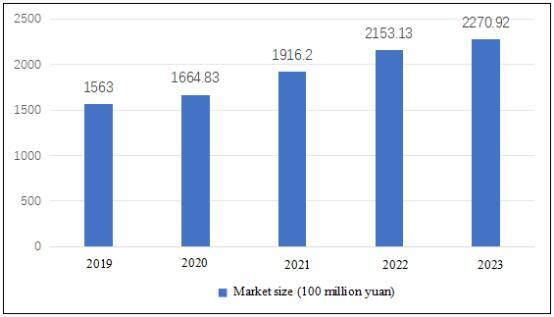
(2) Supply scale
With the advancement of agricultural supply-side structural reform in China, the state’s support for the traditional Chinese medicinal material industry continues to increase. Meanwhile, with change in the population structure and continuous growth of the population, relying solely on wild resources of traditional Chinese medicinal materials is difficult to meet the needs of the people. With changes in people’s health concepts and changes in medical models, the complementary advantages of traditional Chinese medicine and Western medicine have become important features of characteristic medicine and health industry in China, with significant advantages. Such changes directly promote the development of TCM and the expansion of the planting scale of Chinese herbal medicines. The species of Chinese herbal medicines planted in China are becoming increasingly diverse, and the planting scale of traditional Chinese medicinal materials is also constantly increasing. As of 2023, the planting area of Chinese herbal medicines in China has reached 56.26 million mu, with an annual output of about 5.2042 million tons. Under favorable policies, it is expected that by 2025, the area of Chinese medicinal materials in China will have been stable at about 45 million mu, and the area of genuine medicinal materials will have accounted for more than 50% of the total area.
Table 2 Planting Area of Chinese Herbal Medicines in China from 2019 to 2023
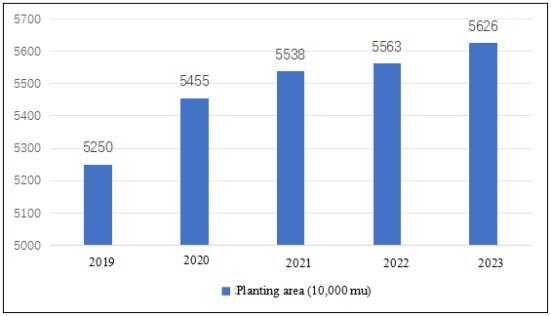
Table 3 Output of Chinese Herbal Medicines in China from 2019 to 2023
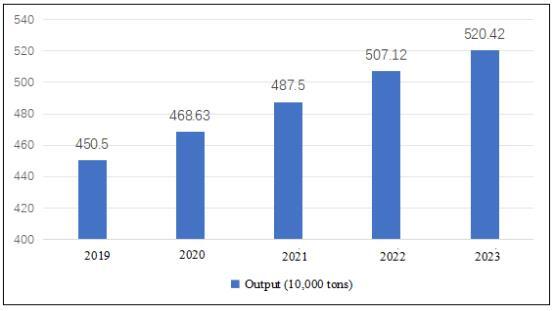
(3) Demand scale
With the development of TCM processing and manufacturing industry, the demand for Chinese herbal medicines in China continues to expand. The sales volume of Chinese herbal medicines in 2023 was about 5.0564 million tons.
Table 4 Sales Volume of Chinese Herbal Medicines in China from 2019 to 2023
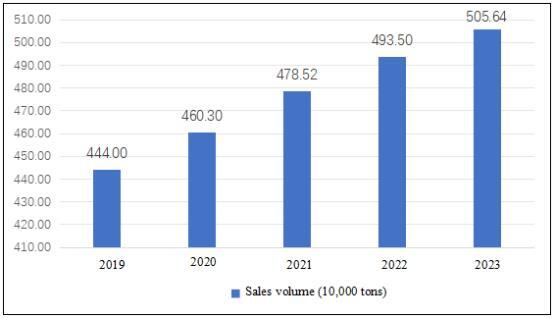
(4) Supply-demand balance analysis of the industry
Overall, although the epidemic has restricted the planting, harvesting, purchase, sales, and circulation, etc. of medicinal materials, which has hindered the large-scale development of traditional Chinese medicinal material planting, it is also the emergence of the epidemic that has made the country begin to pay attention to the development of the traditional Chinese medicinal material planting industry. Under favorable policies, it is expected that the TCM industry in China will usher in development opportunities in the future, with a continuous increase in planting area and stable growth in output and sales volume. From the perspective of output-sales rate, the Chinese herbal medicine industry in China is basically balanced between supply and demand, with an output-sales rate of over 90%. In 2023, the output-sales rate in China was about 97.16%.
2. Development status of downstream industries
(1) Processing of TCM decoction pieces
TCM decoction piece is one of the three pillars of TCM industry, is a traditional weapon necessary for clinical treatment based on syndrome differentiation, as well as an important raw material for traditional Chinese patent medicines. In recent years, with the introduction of multiple important policies, the TCM decoction piece industry has continued to develop and grow, with a very broad industry prospect.
In the past 20 years, the TCM decoction piece industry has developed rapidly and made significant progress. In 2003, China began mandatory GMP certification for TCM decoction piece enterprises, and the development order of the industry was rapidly improved. In 2009, TCM decoction pieces were included in the National Essential Medicine List, greatly promoting the development of the decoction piece industry. In 1996, the total output value of the decoction piece processing industry was 470 million yuan; In 2017, the main operating income reached 216.5 billion yuan, and the industrial scale has grown by 460 times in more than 20 years, with an average annual growth rate of over 30%.
The year 2023 is a key connecting year for China to implement the 14th Five-year Plan for the Development of the Medicine Industry. After the 14th Five-year Plan, the overall TCM market size in China will be stable at more than 1 trillion yuan, including the market size of traditional Chinese medicinal materials will exceed 200 billion yuan, the market size of traditional Chinese patent medicines will be stable at more than 500 billion yuan, and the market size of TCM decoction pieces will be stable at more than 300 billion yuan.
(2) Traditional Chinese patent medicines
Traditional Chinese patent medicine is a kind of TCM products made with Chinese herbal medicines as raw materials and processed into various dosage forms, including pills, powders, creams and pellets. It is the essence of effective prescriptions created and summarized by Chinese medicine scientists through thousands of years of medical practice.
Looking at the market operation condition of traditional Chinese patent medicine industry, its supply and demand have increased steadily, and a number of leading enterprises have emerged. The scale effect has begun to appear. Nowadays, the traditional Chinese patent medicine industry in China has begun to extend to the direction of modernization, consumer goods market and beauty and health care products market, showing a good development prospect in the future.
With the policy support and the accelerated technological research and development of traditional Chinese patent medicines in recent years, traditional Chinese patent medicines have been used more and more in various difficult and miscellaneous diseases. From the perspective of output, the output of traditional Chinese patent medicines in China has gradually declined in recent years, which may be caused by the substitution effect of other forms of TCM varieties. In 2023, the output of traditional Chinese patent medicines in China was 2.106 million tons.
3. Competition pattern of the industry
(1) Competitive echelon of Chinese herbal medicine planting industry in China
Data shows that, the Chinese herbal medicine planting enterprises in China can be divided into three competitive echelons: The first echelon consists of enterprises with a registered capital of over 1 billion yuan, mainly including Jingmao Agriculture, Baiyunshan, KPC Group, Yunnan Baiyao, Zixin Pharmaceutical, Xinbang Pharmaceutical, and Taiji Group; The second echelon consists of enterprises with a registered capital of 500 million to 1 billion yuan, mainly including Yibai Pharmaceutical, LMZ, Tasly, Jiangzhong Pharmaceutical, Tongrentang, Pien Tze Huang, Xiangquan Pharmaceutical, and Dong’e Ejiao. The third echelon consists of enterprises with registered capital below 500 million yuan, mainly including Foci Pharmaceutical and Zhendong Pharmaceutical.
(2) Ranking of Chinese herbal medicine planting industry enterprises in China
According to the announcements of various companies, Baiyunshan Group and its joint ventures have over 60 GAP medicinal material bases, and have established a unified procurement platform for raw materials and excipients. Followed by Tongrentang, which has over 12 GAP bases in total, including Codonopsis pilosula GAP planting base, Cornus officinalis GAP planting base, Licorice and Astragalus membranaceus planting base, etc.
4. Development trend of the industry
With the advancement of agricultural supply-side structural reform in China, the state’s support for the traditional Chinese medicinal material industry continues to increase. Meanwhile, with change in the population structure and continuous growth of the population, relying solely on wild resources of traditional Chinese medicinal materials is difficult to meet the needs of the people. With changes in people’s health concepts and changes in medical models, the complementary advantages of traditional Chinese medicine and Western medicine have become important features and significant advantages of characteristic medical and health industry in China. The species of traditional Chinese medicinal materials planted in China are becoming increasingly diverse, and the scale of traditional Chinese medicinal materials is also constantly increasing, and its output in the total supply of traditional Chinese medicinal materials has reached over 70%. Under favorable policies, it is expected that by 2025, the area of traditional Chinese medicinal materials in China will remain stable at around 45 million mu, with the area of genuine medicinal materials accounting for over 50% of the total area.
1.1.3 Advantageous conditions of project construction
(1) Policy advantages
The Implementation Plan for the Major Projects of Revitalizing and Developing Traditional Chinese Medicine proposed to focus on the whole process of TCM planting, production and use, give full play to the supporting and leading role of science and technology, accelerate the development of traditional Chinese medicinal material seed industry, vigorously promote the standardized planting of traditional Chinese medicinal materials, improve the quality of TCM decoction pieces and traditional Chinese patent medicines, and promote the high-quality development of the TCM industry.
The 14th Five-year Plan for the Development of Traditional Chinese Medicine proposed to improve the specification and standard system for the planting and cultivation, warehousing, logistics, and initial processing of traditional Chinese medicinal materials, encourage the industrialization, commercialization, and appropriate scale development of traditional Chinese medicinal materials, and promote the standardized planting and cultivation of traditional Chinese medicinal materials. Encourage the creation of advantageous characteristic industrial clusters dominated by traditional Chinese medicinal materials and strong agricultural towns dominated by traditional Chinese medicinal materials.
The Outline of the Strategic Plan for the Development of Traditional Chinese Medicine (2016-2030) proposed to implement the Wild Chinese Medicinal Material Resource Protection Project, further improving the reserves of traditional Chinese medicinal materials and TCM decoction pieces, promote standardized planting and cultivation of traditional Chinese medicinal materials, and improve the level of scale and standardization; Build a modern circulation system for traditional Chinese medicinal materials, implement a quality assurance project for traditional Chinese medicinal materials, and establish a quality management and quality traceability system for the entire production and circulation process of traditional Chinese medicinal materials.
The Outline of the 14th Five-Year Plan for National Economic and Social Development and Vision 2035 of Changbai Korean Autonomous County proposed to focus on genuine traditional Chinese medicinal materials such as Schisandra chinensis, Eleutherococcus senticosus, Codonopsis pilosula, and Gastrodia elata, etc., to lay emphasis on development of TCM decoction pieces, TCM extracts, traditional Chinese patent medicines, TCM health care and biopharmaceuticals, etc. We should accelerate the development and achievement transformation of new drugs, and encourage the enterprises to develop innovative drugs with independent intellectual property rights. We should strengthen the construction of quality management system standards in the TCM production process, and build it into a green and organic base for the production, processing, and research and development of traditional Chinese medicinal materials that meets GAP standards.
(2) Resource advantages
Hydropower resources: The controlled boundary river area in Changbai County is 2,497.6 square kilometers, the inland river area is 5,761 square kilometers, the total resource amount is 1.148 billion cubic meters, and the actual utilized water volume is 270 million cubic meters. The theoretical reserve of hydropower resources is 230,000 kilowatts, with a planned installed capacity of 162,300 kilowatts. Among them, the main stream of Yalu River, the boundary river, has a capacity of 127,000 kilowatts, and it is suitable for the development and construction of 7 power stations by the Chinese side, with a planned installed capacity of 58,300 kilowatts; The theoretical reserve of inland rivers is 102,800 kilowatts, with 51 planned power stations and an installed capacity of 84,486 kilowatts. There have been 28 power stations completed, with an installed capacity of 54,700 kilowatts (accounting for 64.74% of the planned installed capacity of inland rivers).
Characteristic industrial resources: Changbai County has a total of 943 species of medicinal plants in 136 families, including 112 species in 55 families that are included in capacity calculation, with a total reserve of 11,500 tons. The main wild genuine traditional Chinese medicinal materials include ginseng, Astragalus membranaceus, Schisandra chinensis, Acanthopanax senticosus, Codonopsis pilosula, and Asarum, etc., with a reserve of up to 1,597 tons. The preserved area of ginseng in the whole county is 3.92 million square meters, including 3.42 million square meters of ginseng and 500,000 square meters of American ginseng; The production area of ginseng as goods is 1.25 million square meters, and the total output of fresh ginseng is 3.66 million kilograms, including 3.3 million kilograms of ginseng and 360,000 kilograms of American ginseng. The artificial planting area of Schisandra chinensis has reached 11,231 mu in accumulation. The planting area of other small and medium-sized medicinal materials, mainly including Dioscorea nipponica, Adenophora stricta, and Asarum, etc., has reached 2,873 mu. There are about 20 varieties of products that comply with organic and green food standards within the county.
Land resources: Changbai County has a total cultivated land area of 14,926.66 hectares, forest area of 220,880 hectares, grassland area of 6,840 hectares, garden area of 1,006.66 hectares, and water area of 2,580 hectares. The other land area is 2,973.33 hectares, and the Changbai Mountain Nature Reserve covers an area of 16,386.66 hectares within the county.
(3) Industrial advantages
In recent years, Baishan City has successfully introduced 15 well-known domestic and foreign enterprises such as Tsumura from Japan, Tongrentang from Beijing, and China Resources Group, etc. It has focused on cultivating leading enterprises such as Zhongmin Kangda, TGpeptide, Nature, China Resources Heshan Tang, and Huangfengshen Industry, etc. It has also developed a batch of deep processed products with core competitiveness, including ginsenosides, ginseng polypeptides, ginseng polysaccharides, ginseng tea treasures, black ginseng, ginseng pure powder tablets, wild ginseng buccal tablets, and Tongrentang ginseng, etc. The ginseng industrial chain has been further extended, forming more than 300 varieties of five major series (ginseng food, drug, health products, cosmetics, and biological products), including more than 200 varieties of ginseng food and more than 60 varieties of cosmetics, and 78 varieties having been approved as medicinal and edible products. It has achieved 5 scientific and research achievements at provincial-level and above, and has developed 58 varieties of new ginseng products. The products such as ginseng dropping pills, ginseng fruit saponin capsules, ginseng peptides, ginseng monomer saponin Rg3, ginseng face cream, and ginseng facial mask, etc. have been greatly favored by the market. In 2023, the total output value of the ginseng processing industry throughout the city was 7.03 billion yuan, accounting for 28.7% of the total output value of the processing industry throughout the province.
Baishan City is fully committed to building the “12345” industrial system for ginseng traditional Chinese medicinal materials, which included cultivating 1 ginseng trading market with a transaction amount exceeding 10 billion yuan, and cultivating 1 traditional Chinese medicinal material trading market with a transaction amount exceeding 5 billion yuan and 1 leading enterprise with an output value exceeding 5 billion yuan each, as well as completing construction of 3 scientific research platforms with the ability to transform scientific research achievements, 4 standardized and guaranteed planting bases for ginseng traditional Chinese medicinal materials with an area of over 1,000 mu, and 5 integrated industrial parks of the three industries with significant regional characteristics. Taking the China Ginseng Industry Demonstration Zone as an important platform, it accelerates the establishment of the Ginseng Industry Development Alliance, promotes the implementation of projects such as Sinopharm Ginseng Medicine Industrial Park, China Resources Sanjiu Industrial Base, and Shanxi Zhendong Pharmaceutical Ginseng and Ganoderma Lucidum Deep-processing, etc., and creates an industrial chain integrating ginseng processing, market logistics, scientific research and development, and quality testing, etc. By now, Baishan City has completed construction and put into use 17 provincial-level entrepreneurship incubation bases, covering an area of 130,000 square meters and incubating 558 enterprises.
(4) Talent advantages
There are 63,800 professional and technical talents in Baishan City; There are 13,000 highly skilled talents, including 39 young and middle-aged experts who have made outstanding contributions; and 13 top-notch innovative talents, having formed a talent team that has initially taken shape, with a relatively complete range of categories and gradually strengthened overall strength. There is Changbaishan Vocational Technical College in the urban area, which is a public ordinary university with higher education enrollment qualifications approved by the Jilin Provincial Government and registered with the national education system. The College is a multi-level and multi-class teaching-oriented higher vocational college that mainly focuses on higher education, takes into account secondary vocational education, and also carries out social training and vocational skills certification education. The College has 18 higher vocational majors for national enrollment and 12 secondary vocational majors for provincial enrollment. The College's training center offers skill training and vocational qualification education for over 30 projects in six major categories, with an annual training capacity of 5,000 person times.
(5) Location advantages
Changbai County is the frontier window of Jilin Province’s opening up to the outside world, and also an important node of China’s “The Belt and Road” Northeast Asia Economic Circle. It has 1 national-level border port and 3 temporary cargo passages, with complete port infrastructure. Over the years, it has been successively awarded the titles of National Culture Advanced County and National Civilized County, and has been named the “National Double-support Model County” for five consecutive times. It has also been honored with the title of National Ethnic Unity and Progress Model Collective for six times.
1.2 Contents and scale of project construction
1.2.1 Construction scale
After the completion of the project, it will produce ginseng at 350,000 kilograms/year, wild ginseng at 12,000 kilograms/year, Eleutherococcus senticosus at 500 tons/year, and Dioscin at 7 tons/year.
1.2.2 Construction contents
The project includes the construction of a ginseng continuous cropping production base covering an area of 100,000 square meters, with 800 hectares of under-forest ginseng, 10,000 mu of Eleutherococcus senticosus, 1,000 mu of Dioscorea nipponica Makino, and 2,000 mu of Gastrodia elata; and formulation of procedures for production technology operation and management related to industrial standardization and normalization.
1.3 Total investment of the project and capital raising
1.3.1Total investment of the project
The total investment of the project is 200 million yuan, including the construction investment of 160 million yuan and current funds of 40 million yuan.
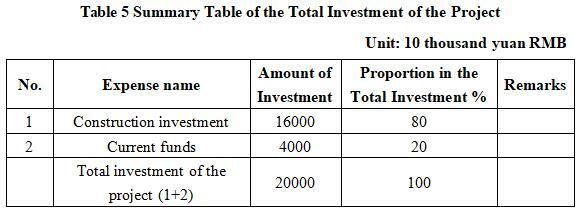
1.3.2 Capital raising
Raised by the enterprise itself
1.4 Financial analysis and social evaluation
1.4.1 Main financial indexes
After the project reaches the production capacity, its annual sales income will be 160 million yuan, its profit will be 23 million yuan, its investment payback period will be 11 years (after the tax, including the construction period of 2 years), and its investment profit rate will be 11.50%.
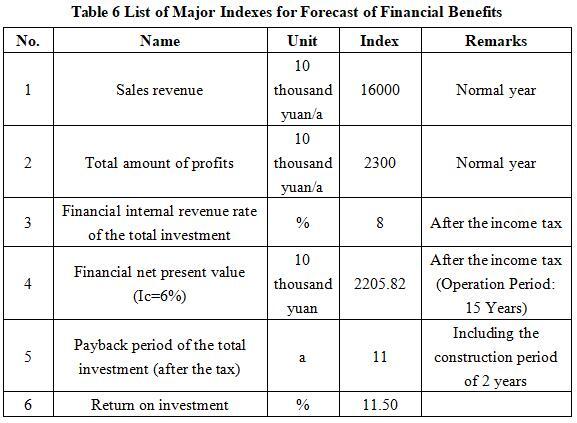
Note: “10 thousand yuan” in the table is in RMB
1.4.2 Social evaluation
The implementation of the project can further improve the utilization rate of land resources, form a modern intensive industrial system for the production and processing of traditional Chinese medicinal materials, and a large-scale traditional Chinese medicinal material industrial park with regional characteristics, effectively promoting the rapid development of ecological agriculture industry. Meanwhile, the project is constructed according to the production standards of characteristic traditional Chinese medicinal material industry, which can improve the planting and operation level of traditional Chinese medicinal material industry in Changbai County, drive and radiate the development of traditional Chinese medicinal material production in surrounding areas, and provide new ways for the development of agricultural industrialization.
1.5 Cooperative way
Joint venture, cooperation, or sole proprietorship, other ways can be discussed in person.
1.6 What to be invested by the foreign party
Funds, other ways can be discussed in person.
1.7 Construction site of the project
Changbai County, BaishanCity.
1.8 Progress of the project
It is in the process of investment promotion/
2. Introduction to the Partner
2.1Basic information
Name: Changbai Korean Autonomous County Commerce Bureau
Address: No. 64 Changbai Street, Changbai Korean Autonomous County
2.2 Overview
As a prefecture-level city under the jurisdiction of Jilin Province, Baishan City is located on the west side of Changbai Mountain, is adjacent to Yanbian Korean Autonomous Prefecture to the east, borders Tonghua City to the west, adjoins Jilin City to the north, and faces the Democratic People’s Republic of Korea across the Yalu River to the south. It is situated in the hinterland of Changbai Mountain, with the Longgang Mountains and Laoling Mountains diagonally running through the entire city. It belongs to the northern temperate continental monsoon climate, with a total area of 17,505 square kilometers. The city has 2 districts, 2 counties and 1 autonomous county under its jurisdiction, and 1 county-level city under its administration as an agent. As of the end of 2023, the population of the city has been 895,900.
Changbai County is located in the southeast of Jilin Province, at the southern foot of the main peak of Changbai Mountain and the source of the Yalu River. It is known as “The First County at the Foot of Changbai Mountain and The First City at the Source of the Yalu River”. Covering an area of 2,505.96 square kilometers, the county has jurisdiction over 77 administrative villages in 7 towns and 1 township, 1 provincial border economic cooperation zone, and 1 provincial diatomite characteristic industrial park. It is the frontier window of Jilin Province’s opening up to the outside world, and also an important node of China’s “The Belt and Road” Northeast Asia Economic Circle. It has 1 national-level border port and 3 temporary cargo passages, with complete port infrastructure. Over the years, it has been successively awarded the titles of National Culture Advanced County and National Civilized County, and has been named the “National Double-support Model County” for five consecutive times. It has also been honored with the title of National Ethnic Unity and Progress Model Collective for six times.
2.3 Contact method
Contact unit: Baishan Municipal Commerce Bureau
Contact person: Zhu Yuze
Tel: +86-439-3367020
+86-15844990231


